ITS Phylogenetics Tool
As currently delimited, the Brassicaceae comprise 52 tribes, 351 genera, and 3977 species. Of these, 11 genera and 19 species remain to be assigned to tribes. These figures differ substantially from those estimated five years ago, in which 49 tribes, 321 genera, and 3660 species were recognized, of which 20 genera and 34 species were lacking tribal assignment (Al-Shehbaz, 2012).
BrassiBase's phylogenetic visualizations are based on a ”synoptic diagram” of phylogenetic relationships“ presented by Franzke et al. (2011) and continuously updated with most recent findings (e.g. Huang et al., 2016).
BrassiBase provides the opportunity to run your own “ITS barcode sequence” (internal transcribed spacers 1 and 2 of nuclear ribosomal DNA, including the 5.8 S gene) as query against the database.
A putative phylogenetic position will be indicated. However, the presented results cannot replace any detailed phylogenetic analysis! This tool is intended only to provide reference points for subsequent own analyses. It should be kept in mind that the presented trees are based on ITS sequences only, and they are also not constraint in their topology by evidence given from other phylogenetic studies. For the pros and cons of ITS sequences as marker in phylogenetic studies please refer to Kiefer et al. (2014).
- Al-Shehbaz, IA. 2012. A generic and tribal synopsis of the Brassicaceae (Cruciferae). Taxon 61(5): 931 – 954.
- Bailey, CD, Koch, MA, Mayer, M, Mummenhoff K, O’Kane, SL, Warwick SI, Windham MD, Al-Shehbaz IA. 2006. A Global nrDNA ITS Phylogeny of the Brassicaceae. Mol. Biol. Evol. 23: 2142–2160.
- Beilstein, MA, Nagalingum, N, Clements, MD, Manchester, SR, Mathews, S. 2010. Dated molecular phylogenies indicate a Miocene origin for Arabidopsis. Proceedings of the National Academy of Sciences, U.S.A. 107(43): 18724 – 18728.
- Franzke A, Lysak MA, Al-Shehbaz IA, Koch MA, Mummenhoff K. 2011. Cabbage family affairs: the evolutionary history of Brassicaceae. Trends Plant Sci. 16(2): 108 – 116. doi: 10.1016/j.tplants.2010.11.005
- Hohmann, H, Wolf, E, Lysak, M, Koch MA. 2015. A Time-Calibrated Road Map of Brassicaceae Species Radiation and Evolutionary History. The Plant Cell 27: 2770-2784.
- Huang CH, Sun R, Zeng YH, Zhang N, Cai L, Zhang Q, Koch MA, Al-Shehbaz IA, Edger PP, Pires JC, Tan DY, Zhong Y, Ma H. 2016. Resolution of Brassicaceae phylogeny using nuclear genes uncovers nested radiations and supports convergent morphological evolution. Molecular Biology and Evolution 33(2): 394 – 412. doi: 10.1093/molbev/msv226.
- Kiefer M, Schmickl R, German DA, Lysak M, Al-Shehbaz IA, Franzke A, Mummenhoff K, Stamatakis A, Koch MA. 2014. BrassiBase: Introdcution to a novel database on Brassicaceae evolution. Plant Cell Physiol., 55(1): e3, doi:10.1093/pcp/pct158.
- Warwick, SI, Mummenhoff, K, Sauder, C, Koch, MA, Al-Shehbaz, IA. 2010. Closing the gaps: Phylogenetic relationships in the Brassicaceae based on DNA sequence data of nuclear ribosomal ITS region. Pl. Syst. Evol. 285: 209-232.
All sequences used in creating the reference alignments for BrassiBase were taken from GenBank. Alignments were initially created using MUSCLE and edited extensively in a subsequent step. All alignments were checked for plausibility using phylogenetic analyses (using Maximum Likelihood methods). Alignments are available for the different Brassicaceae tribes on the corresponding summary pages (use search box to the right, e.g.).
- Benson DA, Cavanaugh M, Clark K, Karsch-Mizrachi I, Lipman DJ, Ostell J, Sayers EW. 2013. GenBank. Nucleic Acids Res 41(Database issue):D36-42
- Edgar RC. 2004. MUSCLE: multiple sequence alignment with high accuracy and high throughput. Nucleic Acids Res 32(5), 1792-97.
- Löytynoja A, Goldman N (2010) webPRANK: a phylogeny-aware multiple sequence aligner with interactive alignment browser. BMC Bioinformatics 11:579
- Junier, T, and Zdobnov, EM. 2010. The Newick Utilities: High-throughput Phylogenetic tree Processing in the UNIX Shell. Bioinformatics 26:1669-1670. [Full text]
- Katoh and Standley. MAFFT multiple sequence alignment software version 7: improvements in performance and usability. Molecular Biology and Evolution 2013 30:772-780
- Stamatakis A. 2006. RAxML-VI-HPC: Maximum Likelihood-based Phylogenetic Analyses with Thousands of Taxa and Mixed Models”, Bioinformatics 22(21):2688–2690.

Brassicaceae tribe phylogeny and statistics
Collapsible tree of Brassicaceae tribes 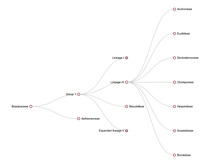 | Number of genera per tribe 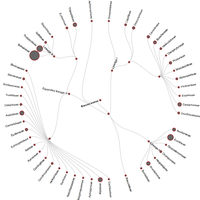 | Number of species per tribe 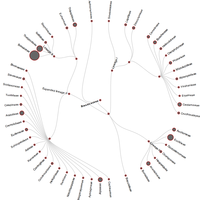 |
Percentage of synonyms in genera of a tribe 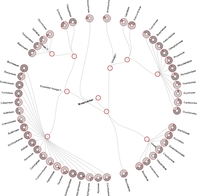 | Standard phylogenetic diagram 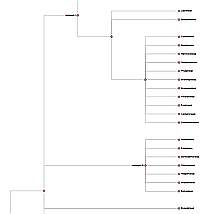 | Radial graph of Brassicaceae tribes  |





